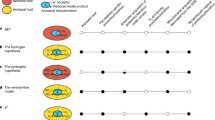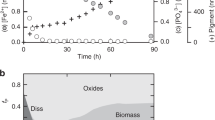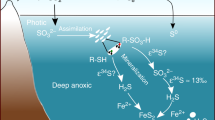Abstract
THE Earth's atmosphere during the Archaean era (3,800-2,500 Myr ago) is generally thought to have been anoxic, with the partial pressure of atmospheric oxygen about 10−12 times the present value1. In the absence of aerobic consumption of oxygen produced by photosynthesis in the ocean, the major sink for this oxygen would have been oxidation of dissolved Fe(II). Atmospheric oxygen would also be removed by the oxidation of biogenic methane. But even very low estimates of global primary productivity, obtained from the amounts of organic carbon preserved in Archaean rocks, seem to require the sedimentation of an unrealistically large amount of iron and the oxidation of too much methane if global anoxia was to be maintained. I therefore suggest that aerobic respiration must have developed early in the Archaean to prevent a build-up of atmospheric oxygen before the Proterozoic. An atmosphere that contained a low (0.2-0.4%) but stable proportion of oxygen is required.
This is a preview of subscription content, access via your institution
Access options
Subscribe to this journal
Receive 51 print issues and online access
$199.00 per year
only $3.90 per issue
Buy this article
- Purchase on Springer Link
- Instant access to full article PDF
Prices may be subject to local taxes which are calculated during checkout
Similar content being viewed by others
References
Kasting, J. F. Precambr. Res. 34, 205–229 (1987).
Henrichs, S. M. & Reeburgh, W. S. Geomicrobiol. J. 5, 191–237 (1987).
Kasting, J. F. & Walker, J. C. G. J. geophys. Res. 86, 1147–1158 (1981).
Cloud, P. E. Econ. Geol. 68, 1135–1143 (1973).
Garrels, R. M. & Perry, E. A. Jr in The Sea, Vol. 5 (ed. Goldberg, E. D.) 303–336 (Wiley, New York, 1974).
Walker, J. C. G. in Handbook of Environmental Chemistry Vol. 1, Part A (ed. Hutzinger, O.) 87–104 (Springer, Berlin, 1980).
Holland, H. D. The Chemical Evolution of the Atmospheres and Oceans (Princeton University Press, 1984).
Walker, J. C. G. & Brimblecombe, P. Precambr. Res. 28, 205–222 (1985).
Kasting, J. F., Zahnle, K. J. & Walker, J. C. G. Precambr. Res. 20, 121–148 (1983).
Schidlowski, M. Nature 333, 313–318 (1988).
Veizer, J. & Jansen, S. L. J. Geol. 93, 625–643 (1985).
Müller, P. J. & Suess, E. Deep Sea Res. A26, 1347–1362 (1979).
Bralower, T. J. & Thierstein, H. R. Geology 12, 614–618 (1984).
Martin, J. H., Knauer, G. A., Karl, D. M. & Broenkow, W. W. Deep Sea Res. 34, 267–285 (1987).
Reimer, T. O., Barghoorn, E. S. & Margulis, L. Precambr. Res. 9, 93–104 (1979).
Towe, K. M. Origins of Life 15, 235–250 (1985).
Wolin, M. J. & Miller, T. L. Geomicrobiol. J. 5, 239–259 (1987).
Claypool, G. E. & Kaplan, I. R. in Natural Gases in Marine Sediments (ed. Kaplan, I. R.) 99–139 (Plenum, New York, 1974).
Winfrey, M. R. & Ward, D. M. Appl. envir. Microbiol. 45, 193–199 (1983).
Rosenfeld, W. D. & Silverman, S. R. Science 130, 1658–1659 (1959).
Schidlowski, M., Hayes, J. M. & Kaplan, I. R. in Earth's Earliest Biosphere (ed. Schopf, J. W.) 149–186 (Princeton University Press, 1983).
Drever, J. I. Geol. Soc. Am. Bull. 85, 1099–1106 (1974).
Chapman, D. J. & Schopf, J. W. in Earth's Earliest Biosphere (ed. Schopf, J. W.) 302–320 (Princeton University Press, 1983).
Hayes, J. M. in Earth's Earliest Biosphere (ed. Schopf, J. W.) 291–301 (Princeton University Press 1983).
Berner, R. A. & Canfield, D. E. Am. J. Sci. 289, 333–361 (1989).
Schopf, J. W. in Molecular Evolution and the Fossil Record (ed. Broadhead, T. W.) 89–97 (University of Tennessee, Knoxville, 1988).
Schwartz, R. M. & Dayhoff, M. O. Science 199, 395–403 (1978).
Towe, K. M. in Molecular Evolution and the Fossil Record (ed. Broadhead, T. W.) 114–129 (University of Tennessee, Knoxville, 1988).
Dymek, R. F. & Klein, C. Precambr. Res. 39, 247–302 (1988).
Moffett, J. W. Nature 345, 421–423 (1990).
Walker, J. C. G., Klein, C., Schidlowski, M., Stevenson, D. J. & Walter, M. W. in Earth's Earliest Biosphere (ed. Schopf, J. W.) 260–290 (Princeton University Press, 1983).
Knoll, A. H. Origins of Life 9, 313–327 (1979).
Author information
Authors and Affiliations
Rights and permissions
About this article
Cite this article
Towe, K. Aerobic respiration in the Archaean?. Nature 348, 54–56 (1990). https://doi.org/10.1038/348054a0
Received:
Accepted:
Issue Date:
DOI: https://doi.org/10.1038/348054a0
This article is cited by
-
Materials and pathways of the organic carbon cycle through time
Nature Geoscience (2020)
-
Interaction of Aromatic Amines with Iron Oxides: Implications for Prebiotic Chemistry
Origins of Life and Evolution of Biospheres (2013)
-
The evolution and distribution of life in the Precambrian eon-Global perspective and the Indian record
Journal of Biosciences (2009)
-
Evolution of the atmosphere and oceans: Evidence from geological records
Resonance (2000)
-
Evolution of the atmosphere and oceans: Evidence from geological records
Resonance (1999)
Comments
By submitting a comment you agree to abide by our Terms and Community Guidelines. If you find something abusive or that does not comply with our terms or guidelines please flag it as inappropriate.



